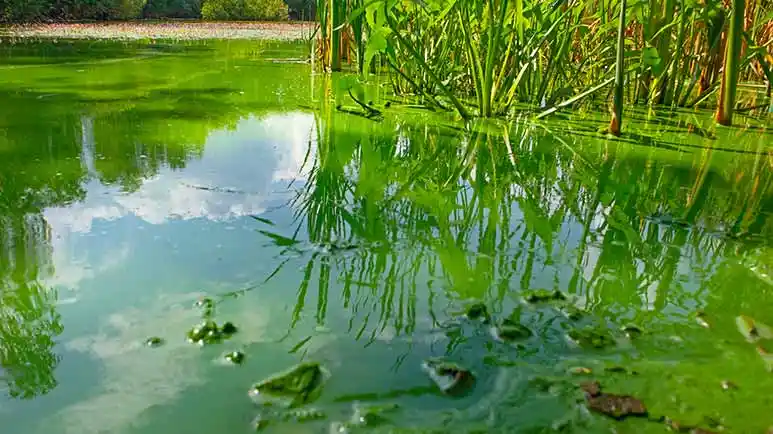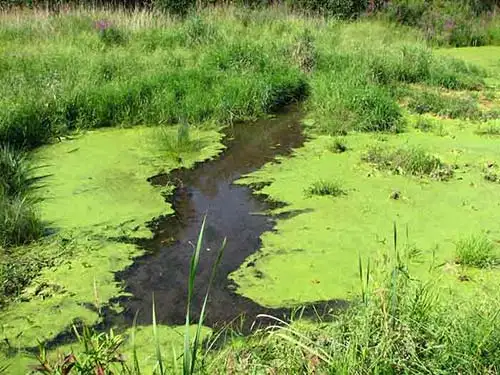The Deadly Threat Lurking in Lakes, Streams and Ponds
Tragically, one family lost all three of their dogs within five to six hours, and only one actually entered the toxic water. These waterways can be found in many locales, even in your own neighborhood. While they may not look threatening at first glance, know what may lie within.

STORY AT-A-GLANCE
- A deadly hazard pet parents should be on the lookout for is toxic blue-green algae, found primarily in freshwater lakes, streams and ponds
- These algal blooms contain cyanobacteria, a toxin that can cause severe illness and death in pets
- Just this past summer, three dogs in North Carolina, a dog in Texas and another in Georgia died after exposure to blue-green algae
- It’s important to note that toxic blue-green algae is entirely different from the superfood species many pet parents feed to their animal companions
- Exposure to blue-green algae is a medical emergency and immediate veterinary care is required
Editor's Note: This article is a reprint. It was originally published October 20, 2019.
Even though summer is now behind us across most of the U.S., warm weather will return in another seven or eight months and so will toxic blue-green algae, a relatively unknown environmental menace that is ending the lives of a growing number of pets every year.
Three Dogs in the Same Family Die Just a Few Hours After Exposure
In August, the problem gained national attention after two women in North Carolina tragically lost all three of their dogs — two Westies, Harpo and Abby, and a larger terrier mix named Izzy — after just one of the dogs splashed around in a pond contaminated with blue-green algae.1
Only Harpo actually got into the water, but when he climbed out, he apparently shook off near Abby and Izzy. As soon as they all arrived home, Abby had a seizure and was rushed to an emergency animal hospital. After learning about the visit to the pond, the veterinary staff told the owners to bring the remaining two dogs in immediately, as all three had likely been infected.
Harpo took his dip in the pond in the early evening hours, and all three dogs were gone just after midnight. This illustrates just how dangerous and quick-acting the toxin in blue-green algae can be. Other deaths attributed to toxic blue-green algae this summer included a 2-year-old Golden Retriever, Oliver, who died just an hour after swimming in a Texas lake, and a Border Collie named Arya, who died after a swim in Lake Allatoona in Georgia.
Dogs Can Be Exposed in a Variety of Ways
Between 2007 and 2011, 13 states (Florida, Iowa, Maryland, Minnesota, New York, North Carolina, Oregon, Virginia, Wisconsin, California, Kansas, Montana and Texas) reported 67 suspected or confirmed cases of dogs being poisoned through exposure to harmful algae blooms.2 The dogs came in contact with the algae in a variety of ways:
- 58 were in fresh water, 1 was in marine water, and 9 exposure sources were unknown
- 9 dogs were made sick by inhaling the blooms, 6 ingested the blooms, 36 were exposed through the skin with accompanying ingestion, and 16 had unknown contact
- 29 dogs had gastrointestinal symptoms (vomiting and diarrhea)
- Other symptoms included lethargy (12 cases) and neurologic signs, including stumbling or change in behavior (6 cases)
While the most common victims of blue-green algae are dogs, other animals are also at risk, including cats, birds, horses, livestock and wildlife that drink from contaminated bodies of water or groom themselves after a swim. In humans, exposure to harmful algae can cause a skin rash, hives, runny nose, irritated eyes and throat irritation. If water containing the toxic blooms is swallowed it can cause nausea, vomiting, diarrhea, headache, throat irritation and muscle pain.
The Deadly Culprit: Cyanobacteria
Blue-green algae blooms thrive in warm temperatures and are prevalent in areas where heavy spring and summer rains carry fertilizer and sewage into waterways.3 The algae contain deadly microorganisms called cyanobacteria, which are microscopic organisms found in freshwater lakes, streams, ponds (including backyard ponds), and brackish (salty) water ecosystems.
The algae give the water a blue-green or "pea soup" appearance, almost as if someone spilled blue or green paint on the surface of the water. These floating blooms can form thick, dense mats that collect near the shore, which is where animals and people come in contact with them.

Blue-green algae are prevalent in the mid-to-late summer months and are most often found in nutrient-rich water. The algae tend to bloom in locations where there is heat and low water flow combined with high levels of nutrients like nitrogen and phosphorus. Not all blue-green algae are toxic, but there's no way to know whether a plant is poisonous without testing. According to the Food Poisoning Bulletin:
"There is no way to tell if a blue-green algal bloom is toxic by looking at it. The harmful blooms look like pea soup, green paint, or floating mats of scum. They sometimes have a bad smell. But these blooms aren't always large and dense and can be present in a lake with little visible algae.
Before you, your children, or your pets go into the water, look at the lake closely to see if there is algae on the water or on the shore."4
Experts advise that all blooms floating on natural bodies of water should be considered potentially toxic. As was the case with the three dogs in NC, even minor exposure can be lethal.
Important note: The toxic type of blue-green algae is obviously very different from the species that is considered a superfood. It can be very confusing to pet parents to hear about toxic algae blooms because many feed medicinal algae to their pets as a whole food supplement.
The algae grown in controlled environments for the nutraceutical, supplement and food industries are entirely different than the algae that naturally bloom in lakes and ponds. Spirulina and other types of health-giving algae are popular supplements and have been proven to be safe and very beneficial.
Symptoms of Toxicity in Animals
Symptoms of blue-green algae toxicity include:
- Vomiting
- Muscle rigidity
- Diarrhea
- Pale mucous membranes
- Blood in the stool or black tarry stool
- Bluish discoloration of skin and mucous membranes
- Excessive drooling or tearing
- Jaundice
- Disorientation
- Seizures
- Muscle tremors
- Shock
- Difficulty breathing
- Coma
Symptoms depend on the toxin involved. Toxins that attack the liver cause elevated liver enzymes, low blood sugar, low protein, and occasionally, abnormal clotting activity. These toxins can result in liver damage or failure and immediate aggressive treatment is necessary to save the animal.
Exposure to another type of toxin found in blue-green algae, anatoxins, results in nervous system symptoms and can bring death in minutes to hours due to respiratory paralysis.
Exposure to Blue-Green Algae Is a Life-Threatening Medical Emergency
No antidote currently exists for the toxins produced by blue-green algae. If you suspect your pet has been exposed, rinse him with fresh water, administer high-potency homeopathic Nux Vomica if possible, and seek immediate emergency veterinary care.
Your veterinarian or emergency animal hospital staff may induce vomiting if your dog isn't yet showing signs of poisoning. Symptomatic patients may need to be hospitalized to receive life-saving treatments such as intravenous (IV) fluids, medications to control seizures or vomiting, oxygen therapy and blood transfusions.
Unfortunately, death may occur within hours of exposure, even with aggressive treatment, which is why preventing exposure is so important. If you see a body of water that is a greenish color, play it safe and steer clear.











